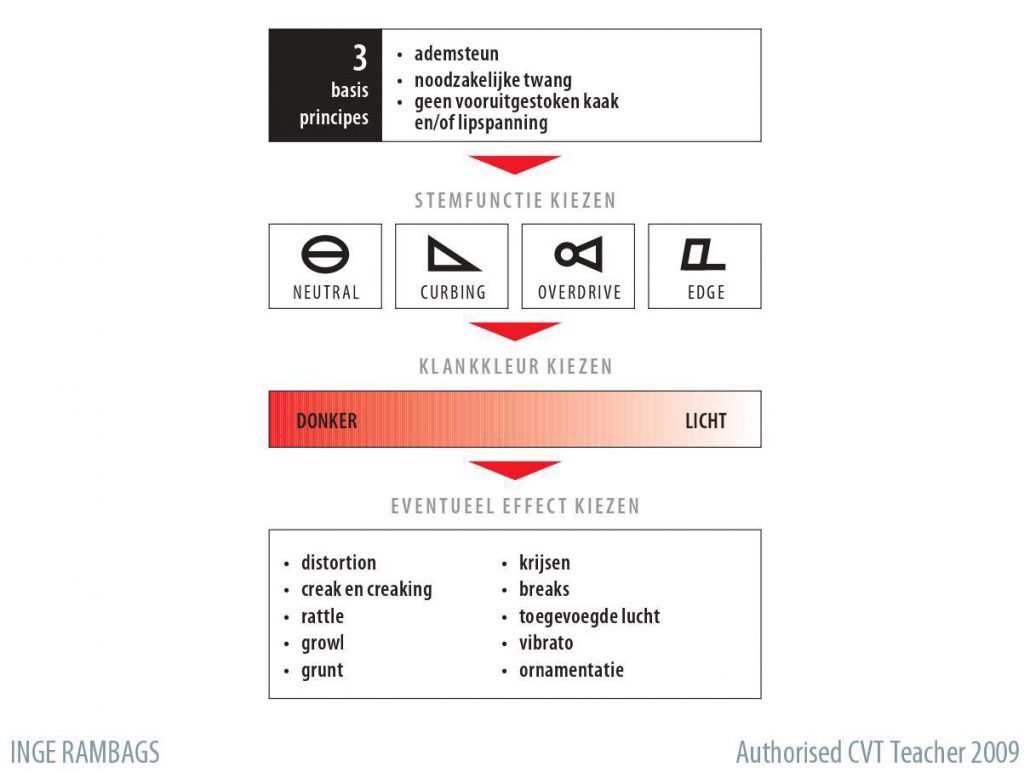CVT
CVT is short for ‘Complete Vocal Technique’, a singing technique method developed by Cathrine Sadolin. The following pages contains an extract from the book ‘Complete Vocal Technique’. In the book there are references to 60 audio clips in this chapter, and a few of them are inserted into the text here.
Graphical overview of CVT
CVT explained
Singing is not that difficult and everybody can learn to sing. I have divided the singing techniques into four main subjects as listed below. By combining elements of these four subjects you can produce precisely the sounds you want. You will also be able to pinpoint your specific problems and mistakes, and you can focus on which techniques you wish to work on. Here I have condensed ‘Complete Vocal Technique’ into four pages. You can return to these pages at any time to give yourself an overview of the contents of this book. The four main subjects are: The three overall principles – to ensure healthy sound production. The four vocal modes – to choose the ‘gear’ you want to sing in. Sound colours – to make the sound lighter or darker. Effects – to achieve specific sound effects.
The three overall principles
The three overall principles are the most fundamental and important to perfect. They make it possible to reach all the high and low notes within the range of the individual singer, to sing long phrases, to have a clear and powerful voice and to avoid hoarseness.
The three overall principles must be obeyed regardless of mode, sound colour, and effect. They are:
1. Support
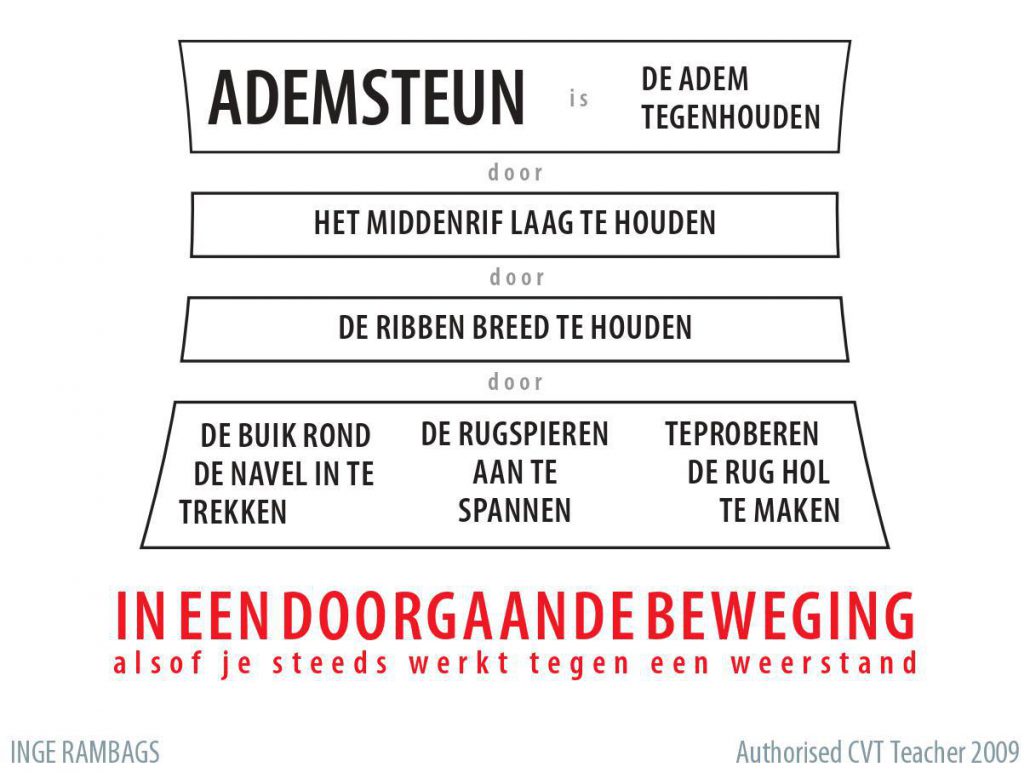 This means working against the natural urge of the diaphragm to release the air that has been inhaled. This is achieved by resisting its movement. During singing, the waist muscles and solar plexus are pushed outwards whilst the abdomen around the navel is gradually pulled in in a constant and sustained manner and the back muscles are tightened. The muscles in the loin try to pull the pelvis backwards, while the muscles in the abdomen try to pull the pelvis up under your body. This battle created between the abdominal muscles and the muscles in the loin is a valuable and important part of support. However, the support must happen in a sustained and continuous manner as though working against a resistance for as long as a sound is being produced. When the muscle contractions stop being sustained and continuous, for instance if you cannot pull the abdomen around the navel inwards any further or push the muscles of the waist or solar plexus outwards any further, then there is usually no more support. It is important to conserve your support energy so you do not waste it or use it at the wrong point in time. Do not use support before it is necessary. Save it for when the singing gets difficult, such as on high notes or at the end of a phrase. Support is hard physical work so you should be in good physical condition.
This means working against the natural urge of the diaphragm to release the air that has been inhaled. This is achieved by resisting its movement. During singing, the waist muscles and solar plexus are pushed outwards whilst the abdomen around the navel is gradually pulled in in a constant and sustained manner and the back muscles are tightened. The muscles in the loin try to pull the pelvis backwards, while the muscles in the abdomen try to pull the pelvis up under your body. This battle created between the abdominal muscles and the muscles in the loin is a valuable and important part of support. However, the support must happen in a sustained and continuous manner as though working against a resistance for as long as a sound is being produced. When the muscle contractions stop being sustained and continuous, for instance if you cannot pull the abdomen around the navel inwards any further or push the muscles of the waist or solar plexus outwards any further, then there is usually no more support. It is important to conserve your support energy so you do not waste it or use it at the wrong point in time. Do not use support before it is necessary. Save it for when the singing gets difficult, such as on high notes or at the end of a phrase. Support is hard physical work so you should be in good physical condition.
2. Necessary Twang
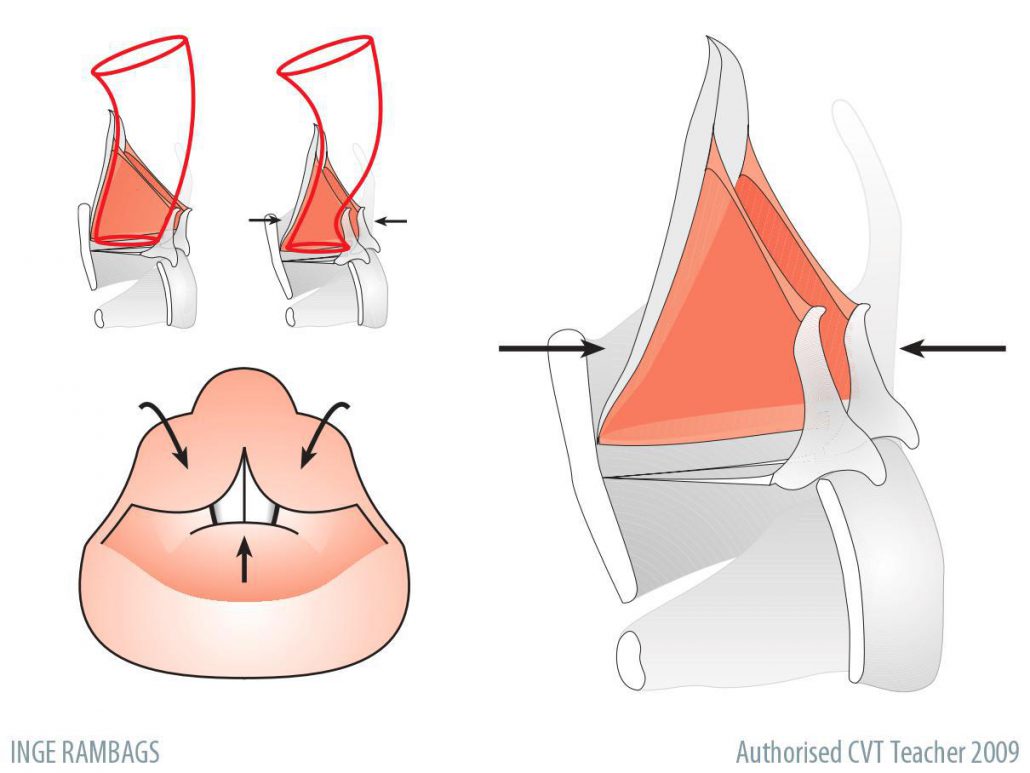 The area above the vocal cords forms a funnel, this is called the ‘epiglottic funnel’. When twanging, the opening of the epiglottic funnel is made smaller by bringing the arytenoid cartilages closer to the lower part of epiglottis (the petiole). As a result the sound gets clearer and non-breathy, and you can increase your volume. You always need to use necessary twang in order to have correct technique and achieve easy and unhindered use of the voice regardless of the mode, sound colour and effect used. Necessary twang makes it easier to sing in all ways. For many this necessary twang does not sound twanged at all.
The area above the vocal cords forms a funnel, this is called the ‘epiglottic funnel’. When twanging, the opening of the epiglottic funnel is made smaller by bringing the arytenoid cartilages closer to the lower part of epiglottis (the petiole). As a result the sound gets clearer and non-breathy, and you can increase your volume. You always need to use necessary twang in order to have correct technique and achieve easy and unhindered use of the voice regardless of the mode, sound colour and effect used. Necessary twang makes it easier to sing in all ways. For many this necessary twang does not sound twanged at all.
3. Avoid protruding the jaw and tightening the lips
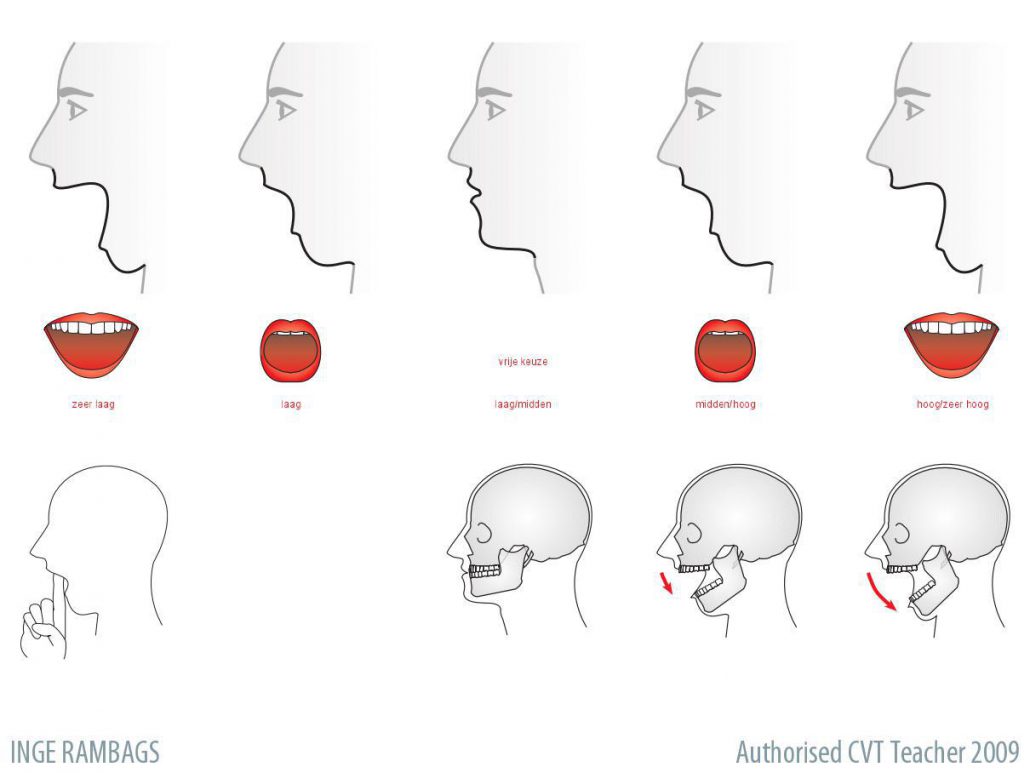 Avoid protruding the jaw and tightening the lips as it often produces uncontrolled constriction around the vocal cords. Achieve a correct jaw position by bending your head back and placing a finger between the upper and lower jaw. Keep this position of the jaw as you sing. The lower jaw should be pulled backwards relative to the upper jaw. Be sure to open the mouth wider on high and low notes than on notes in the middle part of the voice.
Avoid protruding the jaw and tightening the lips as it often produces uncontrolled constriction around the vocal cords. Achieve a correct jaw position by bending your head back and placing a finger between the upper and lower jaw. Keep this position of the jaw as you sing. The lower jaw should be pulled backwards relative to the upper jaw. Be sure to open the mouth wider on high and low notes than on notes in the middle part of the voice.
Whilst avoiding tightening the lips, it is also important to form vowels with the tongue without altering the shape of the mouth too much. Consonants on the other hand are usually produced by narrowing the vocal tract and by tension in the lips, but as you do not stay on them for very long in singing they do not impair singing. It is important to be able to release the tension immediately going from consonants to vowels.
Four vocal modes
The use of the voice can be divided into four vocal modes: Neutral, Curbing, Overdrive and Edge (formerly ‘Belting’). The modes differ by having different amounts of metallic character. Most singing problems occur because of incorrect use of the modes. Each mode has a certain character, as well as advantages and limitations. To avoid mistakes and technical problems it is important to know and control the modes, to use their advantages and to respect their limitations. It is also important to be able to change freely between the modes in order to make the most of their advantages. You can change smoothly or make abrupt changes to achieve vocal breaks. Each of the four vocal modes should be trained individually and in different ways. Remember to obey the three overall principles regardless of the mode.
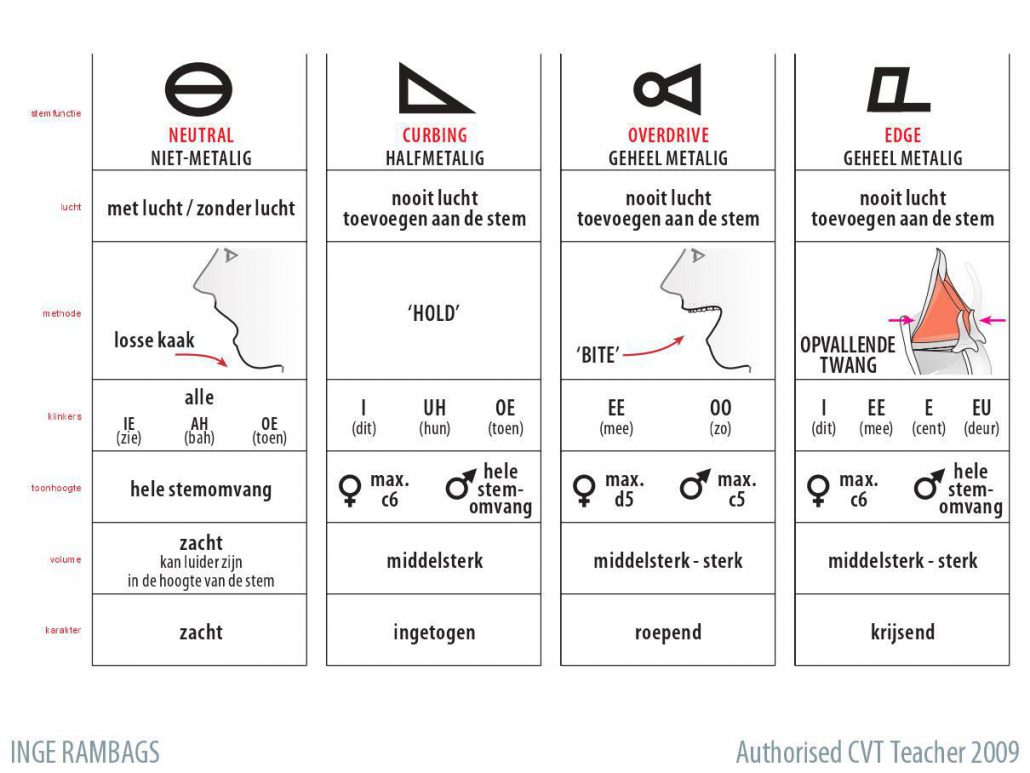
Neutral
Neutral is the only non-metallic mode. There is no ‘metal’ in the sound.
The character is usually soft, like singing a lullaby.
Neutral is the only mode where you can sing using a breathy quality voice without causing damage.
The two extremes of Neutral are called ‘Neutral with air’;For the sake of clarity, both extremes are sometimes shown individually.
Neutral is found by establishing a loose jaw.
In popular music Neutral with air is used for quiet passages when a breathy sound is wanted. In classical music Neutral with air is only used as a rare effect. In everyday life Neutral with air is used when you speak in a breathy voice or whisper.
Neutral without air is often used in popular music when you want a sound without metal and yet be clear and non-breathy. In classical music Neutral without air is used by both men and women when singing quietly, i.e. in pianissimo and ‘thinning’ (the volume of the note is gradually decreased without the note losing its quality). Women use Neutral without air in classical music when they sing in the high part of their voice, regardless of volume. In everyday life Neutral without air is used when you speak quietly with no breathiness.
All parts of the voice, all vowels and all sound colours can be used in Neutral by both men and women. Generally, Neutral is a mode with a quiet volume from very quiet (pp) to medium loud (mf). Very powerful volumes (ff) can only be obtained in Neutral without air in the high part of the voice. In the West, Neutral is the most commonly taught mode in singing tuition (for women), and is often used in church and school choirs (see ‘Neutral’ on page 87).
Curbing
Curbing is the only half-metallic mode. There is a slight ‘metal’ on the notes. Curbing is the mildest of the metallic modes. It sounds slightly plaintive or restrained, like when you moan because of a stomach ache. Curbing can be found by establishing a ‘hold’.
Curbing is used in popular music when the volume is around medium and when a certain amount of metal is wanted on the notes such as in soft soul or R ‘n B. Curbing is used in classical music by men when singing medium volume (mf) in their entire range and when women singing loud (f) in the middle part of the voice and sometimes in the low part of the voice. Curbing is used in everyday life when you wail, moan, or whine.
Men and women use Curbing through all the various parts of the voice. The sound colour can be altered quite a lot. All vowels can be used. However, in the high part of the voice, the vowels have to be directed towards ‘O’ (as in ‘woman’), ‘UH’ (as in ‘hungry’), and ‘I’ (as in ‘sit’) to stay in the mode. The volume in Curbing stays more or less in medium compared to the other modes, ranging from medium quiet (mp) to medium loud (mf). It is not possible to sing very quietly and very loudly in this mode.
Overdrive
Overdrive is one of two full-metallic modes. There is a great amount of metal in the notes. The character of Overdrive is often direct and loud, like when you shout ‘hey’ at somebody in the street. Overdrive can be found in the beginning by establishing a ‘bite’. It is usually used when speaking or singing loudly in the low part and middle part of the voice.
Overdrive is used in popular music when the volume is loud and when a great amount of metal is wanted on the notes, such as in rock music. In classical music it is used by men when they sing medium loud to very loud (f-ff), and women use Overdrive in classical singing only in the low part of the voice if at all. Overdrive is used in everyday life, for example when shouting.
Overdrive is the most limited mode in terms of pitch, especially for women. The upper limit for women is D5/Eb5 and for men is C5. There is no lower limit. All vowels can be used in the low part of the voice, but in the high part of the voice you can only use ‘EH’ (as in ‘stay’) and ‘OH’ (as in ‘so’). The sound colour can, however, be altered to some extent. Although the volume in Overdrive is mostly loud, relatively quiet volumes can be obtained in the lower part of the voice. The higher the notes, the more distinct the loud, shouting character becomes.
Edge
Edge (formerly ‘Belting’) is the other full-metallic mode. There is a great amount of metal in the notes. The character of Edge is light, aggressive, sharp, and screaming, like when you imitate a diving airplane. Edge can be found by twanging the epiglottic funnel (e.g. sounding like a duck).
Edge is used in popular music in some styles, and mostly in the high part of the voice when the volume needs to be very loud and with a great amount of metal on the notes, such as in heavy rock and gospel music. Edge is used in classical music when men sing very loudly (ff) often in the high part of the voice such as the high C of a tenor. Women do not use Edge in classical music. Edge is used in everyday life when you scream.
Men can use Edge in all parts of the voice. Women can use Edge to the high C. It’s not possible to for a woman to sing above in Edge. Only twanged vowels can be used as the twanged epiglottic funnel is a condition of Edge. This means that in the high part of the voice you can only use ‘I’ (as in ‘sit’), ‘A’ (as in ‘and’), ‘EH’ (as in ‘stay’), and ‘OE’ (as in ‘herb’). The sound colour can only be altered a little. In the high part of the voice you must not alter the light and sharp sound colour. The volume in Edge stays mostly loud. The higher the notes, the more distinct the screaming character becomes.
Sound colour
All modes can be lightened or darkened, though some more than others. The sound colour is created in the vocal tract, which is the space above the vocal cords extending to the lips and including the nasal passages. The form and size of the vocal tract is of great importance to the sound colour. All singers have different vocal tracts so all singers have their own personal sound colour. If the vocal tract is large, the sound colour will be darker with more ‘body’ to it. If it is small, the sound will be lighter and thinner. The shape of the vocal tract can be altered in many directions so there are many ways of changing the sound colour of your voice.
Remember to obey the three overall principles and to be in control of the chosen mode before changing sound colour.
You can change the shape of the vocal tract by changing the:
- shape of the epiglottic funnel
- position of the larynx
- shape of the tongue
- shape of the mouth
- position of the soft palate
- opening or closing of the nasal passages
Each of these factors can and should be trained individually in order to get to know each factor’s influence on the sound colour. Once you can control each factor individually they can be combined in different ways to achieve different sound colours.

Effects
These are sounds which are not connected to melody or text but are sounds that underline the expression or style of a singer. Many effects are produced in the vocal tract. All singers are different. Consequently, every effect must be specifically designed to each singer, taking into account their anatomy, physiology, fitness, energy level, and temperament.
Before you start working with effects it is important that you can control the three overall principles, the chosen mode, and the sound colour.
Effects might be:
- Distortion
- Creak and creaking
- Rattle
- Growl
- Grunt
- Screams
- Intentional vocal breaks
- Air added to the voice
- Vibrato
- Ornamentation technique (rapid run of notes)
CVT philosophy
Singing is not difficult
The voice is not as complicated to use as many people think. It is an instrument that everybody has and uses every day. Of course it requires practice to sing professionally, but when you know how the voice works and how to use its natural functions and develop them further, you will be able to learn most of what is required.
The voice usually works perfectly until we hinder it during childhood with constriction. Singing techniques are mostly about removing constriction to allow the voice to work freely. This means everyone can sing if they do not hinder their voice production. Therefore there is no reason to work with the technical aspects of singing unless you think you have a specific technical singing problem.
Technique and expression
The CVT book however is mainly about technique – this is not because we believe technique is the most important aspect of singing. On the contrary, technique is only the MEANS by which we express ourselves. At CVI we think the most important aspect is EXPRESSION – to convey a message. What to convey and how to convey it are artistic choices that every singer has to make for her/ himself. The CVT book is about the techniques required to accomplish the artistic choices you would like to make.
The history of singing
In the old days you could not amplify the voice electronically so singers had to find a way to be heard from a considerable distance. This led to the development of certain vocal techniques that gradually became the only right vocal sound to be produced. In the Western world this taught sound became known as the ‘classical sound’.
With the invention of the microphone it became possible to amplify all sounds including those that were previously too quiet to be heard from a distance. This brought new ‘untaught’ sounds to the same volume as ‘taught’ sounds. This meant that many new sounds of the voice could be used and that new ideals emerged for what constituted a ‘good’ sound.
Many of the ‘new’ ways of singing turned out to be just as strenuous and difficult as the ‘taught’ ways. New style singers, who became known as singers of ‘popular music’, had to learn how to sing healthily by themselves because teaching in the new singing styles was not available. They could not get help from classical singing techniques as these resulted in a classical sound which they were not interested in. As a result of this lack of tuition some new singers damaged their voices and their singing styles were labelled as dangerous and unhealthy – even though many classical singers also had vocal problems.
In the ‘popular music’ camp some singers made a virtue of necessity and declared that ‘true’ singers of popular music should be self-taught, claiming that tuition would remove a singer’s special touch. Both camps nurtured their prejudices against each other. A gulf between the classical and the popular camps developed which, unfortunately, still exists today to some degree. This gulf is more about taste than of the use of techniques.
Amongst the ‘popular music’ singers who lost their voices were those who fell by the wayside in practice rooms and you never heard of them. Some lost their voices at the beginning when they started touring or later on in their careers due to the strain and increased demands on their voice. But there WERE ‘popular’ singers whose voices ‘lasted’ throughout their careers regardless of how strained they sounded.
It is therefore from both the techniques from the ‘classical’ school and the experience of these ‘popular’ singers that I base many of the new singing techniques on today.
Myths about singers
There are many myths about performers before the days of recording: ‘This was a voice like none other, never to be heard again’ and so on. We don’t believe this is true. It is probable that it was not the performer’s voice that was so special but her/his technique in producing the voice. We can all accomplish a good technique by knowing what and how to practise.
Unfortunately, we can only accept the myths about past performers because we have no recordings to prove or disapprove them as, of course, their voices died with them. We believe that all singers can accomplish all sounds. Since recordings began there has not been a sound that cannot be taught.
Myths about singing techniques
Being able to see what you are doing is an invaluable tool in learning. Unfortunately, singing tuition cannot rely on sight and that lead to myths about how sound is produced. Thankfully, science now provides new knowledge so we know much more about the working of the vocal cords today. We are now able to watch the vocal cords work and we know more about the anatomy and physiology of voice production. This has helped to eliminate many of the previous misconceptions and myths that were based largely on guesswork, many of which contributed to ruined voices and careers.
With a better understanding of voice production months of wasted and harmful training can now be avoided. When teachers can be specific in their instructions, singers no longer have to go through years of training based on vague directions. When you can work on a problem directly, it is easier to determine whether you are on the right track or not. A technique must have the intended effect immediately otherwise it is not being done correctly. Experience also shows us that singers who perfect these new techniques are able to last on strenuous tours which is one of the reasons why the techniques today have the backing of doctors and speech therapists.

